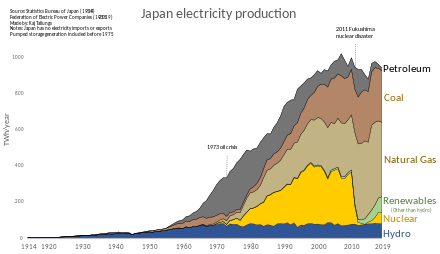This article needs to be updated. (July 2022) |

| Data | |
|---|---|
| Production (2014) | 995.26 TWh |
| Share of renewable energy | 9.7% (2009) |
The electric power industry in Japan covers the generation, transmission, distribution, and sale of electric energy in Japan. Japan consumed approximately 918 terawatt-hours (TWh) of electricity in 2014.[1] Before the 2011 Fukushima Daiichi nuclear disaster, about a quarter of electricity in the country was generated by nuclear power. In the following years, most nuclear power plants have been on hold, being replaced mostly by coal and natural gas. Solar power is a growing source of electricity, and Japan has the third largest solar installed capacity with about 50 GW as of 2017. Japan's electricity production is characterized by a diverse energy mix, including nuclear, fossil fuels, renewable energy, and hydroelectric power.
Japan has the second largest pumped-hydro storage installed capacity in the world after China.[citation needed]
The electrical grid in Japan is isolated, with no international connections, and consists of four wide area synchronous grids. Unusually the Eastern and Western grids run at different frequencies (50 and 60 Hz respectively) and are connected by HVDC connections. This considerably limits the amount of electricity that can be transmitted between the north and south of the country.
During the Second Sino-Japanese War and the succeeding Pacific War, the entirety of Japan's electricity sector was state-owned; the system at the time consisted of a Japan Electric Generation and Transmission Company (日本発送電株式会社, Nippon Hassōden kabushiki gaisha, otherwise known as Nippon Hassōden KK or Nippatsu) and several electricity distributors. At the behest of the Supreme Commander for the Allied Powers, Nippon Hassōden became the Electric Power Development Co., Limited in the fifties; and almost all of the electricity sector that are not under the control by EPDC was privatized into nine government-granted monopolies. The Ryukyu Islands electricity provider was, during the USCAR era, publicly owned; it was privatized shortly after the islands' admission into Japan.
- ^ "2016 Key World Energy Statistics" (PDF). www.iea.org. IEA. Retrieved 1 August 2016.